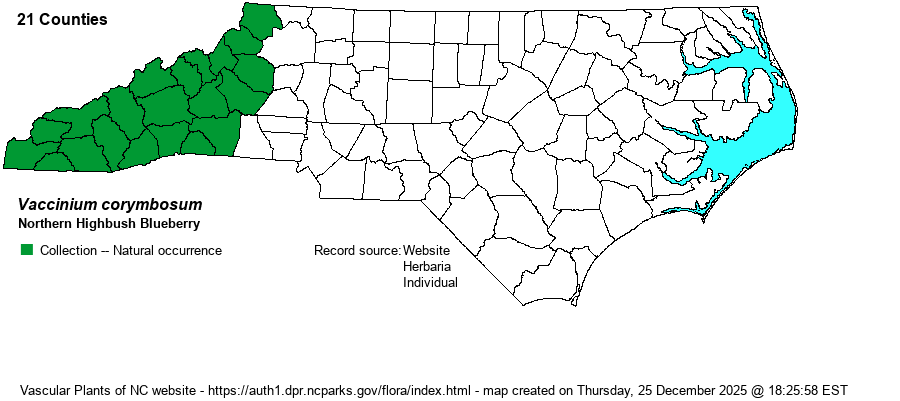| Section 6 » Order Ericales » Family Ericaceae |
Show/Hide Synonym
| taxonName | relationship | relatedTaxonName | relatedTaxonRefText | relComments |
|---|
|
|
|
|
|
| Vaccinium corymbosum | > | Vaccinium corymbosum var. albiflorum | Fernald (1950) | | | Vaccinium corymbosum | > | Vaccinium corymbosum var. corymbosum | Fernald (1950) | | | Vaccinium corymbosum | > | Vaccinium corymbosum var. corymbosum | Flora of West Virginia | | | Vaccinium corymbosum | > | Vaccinium corymbosum var. glabrum | Fernald (1950) | | | Vaccinium corymbosum | > | Vaccinium corymbosum var. glabrum | Flora of West Virginia | | | Vaccinium corymbosum | < | Vaccinium corymbosum | Gleason and Cronquist (1991) | | | Vaccinium corymbosum | < | Vaccinium corymbosum | Flora of North America (1993b, 1997, 2000, 2002a, 2002b, 2003a, 2004b, 2005, 2006a, 2006b, 2006c, 2007a, 2009, 2010) | | | Vaccinium corymbosum | < | Vaccinium corymbosum | Gleason (1952) | | | Vaccinium corymbosum | < | Vaccinium corymbosum | Stevens et al. in Kubitzki (2004). Key based in part on Uttal (1987). | | | Vaccinium corymbosum | < | Vaccinium corymbosum | | | | Vaccinium corymbosum | < | Vaccinium corymbosum | Radford, Ahles, and Bell (1968) | | | Vaccinium corymbosum | < | Vaccinium corymbosum | | | | Vaccinium corymbosum | < | Vaccinium corymbosum | Wofford (1989) | | | Vaccinium corymbosum | < | Vaccinium corymbosum | Stevens et al. in Kubitzki (2004). Key based in part on Uttal (1987). | | | Vaccinium corymbosum | < | Vaccinium constablaei | Gleason (1952) | | | Vaccinium corymbosum | < | Vaccinium constablaei | Stevens et al. in Kubitzki (2004). Key based in part on Uttal (1987). | | | Vaccinium corymbosum | = | Cyanococcus corymbosus | Small (1933, 1938) | | | Source: Weakley's Flora |
|
| Author | L. | |
| Distribution | Essentially throughout the Mountains, and perhaps also on some western Piedmont monadnocks. The taxon formerly named as this species in RAB (1968) and most other references is now limited to more northerly and higher elevation populations; the lower elevation populations are now either V. formosum or V. caesariense. Note that there are numerous specimens of "corymbosum" in SERNEC from much of the Piedmont, but whether these belong to this species or to formosum is unclear at the present time, especially as Weakley (2024) considers both as present but rare in this province.
This is a Northern species that ranges south to northwestern SC, northern GA, and eastern TN. It occurs north to NS and MI, but south of WV it is essentially limited to the Appalachians. Note that the BONAP map includes V. formosum and V. caesariense (i.e., a large number of Coastal Plain and Piedmont county records).
| |
| Abundance | Apparently fairly common in the Mountains, but local in the western Piedmont, mainly at the higher elevations there. Whether it is present over most of the Piedmont is unclear, though Weakley (2024) feels that corymbosum is primarily a montane species in NC. | |
| Habitat | This is primarily a wetland species, found in bogs, swamps, and other poorly drained wetlands. However, it does occur on some heath balds and around the tops of granitic domes and other outcrops, especially near seepages. | |
| Phenology | Blooms mainly in May, after the leaves are emerging and probably not fully expanded; fruits mostly in August. | |
| Identification | This species is very similar to both V. caesariense and V. formosum of the Coastal Plain, being fairly tall (5-10 feet) deciduous shrubs primarily of wet places. However, as those two do not occur with this species, V. corymbosum must be separated mainly from V. fuscatum. V. corymbosum has white flowers with petals not narrowed to the tip, whereas V. fuscatum has slightly smaller flowers (often with a pinkish tinge) with petals narrowed to the tip. V. fuscatum also blooms before or as the leaves emerge, usually from late February to April, whereas V. corymbosum blooms mainly in May after the leaves are well formed. Leaves of V. corymbosum are medium to light green above, whereas V. fuscatum leaves average dark green above; the former has glaucous blue berries, whereas the latter has black berries. There are several small-stature blueberries on mountain outcrops, heath balds, and domes, usually growing to just knee or waist height. V. corymbosum typically is head height or taller. | |
| Taxonomic Comments | What most people know as Vaccinium corymbosum, especially using the RAB (1968) manual, has now been split at least into three species (includes V. caesariense and V. formosum), leaving the strict-sense V. corymbosum limited in the state just to the Mountains and foothills.
| |
| Other Common Name(s) | Highbush Blueberry (used for the old/combined V. corymbosum) | |
| State Rank | S4 | |
| Global Rank | G5 | |
| State Status | | |
| US Status | | |
| USACE-agcp | FACW link |
| USACE-emp | FACW link |

